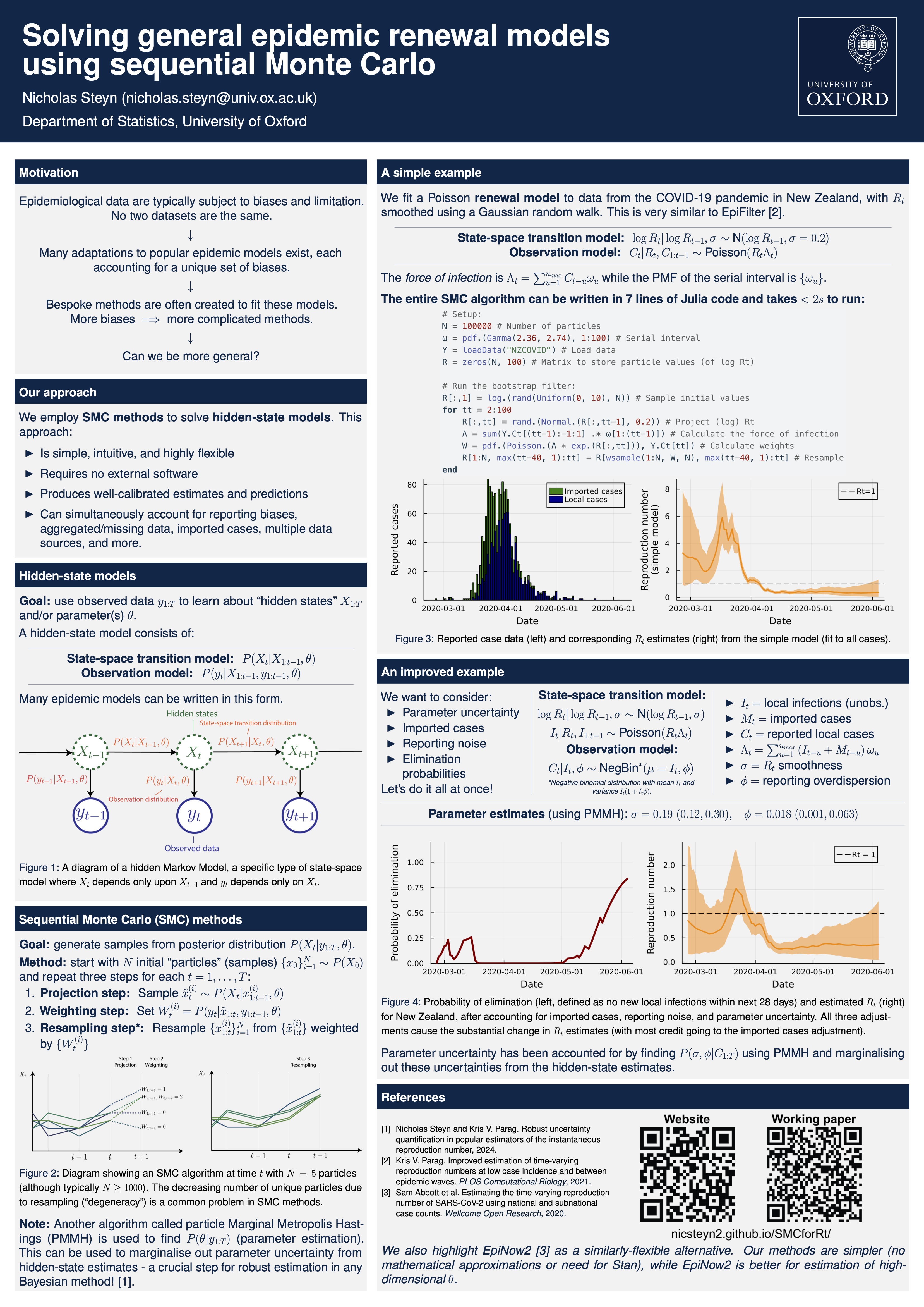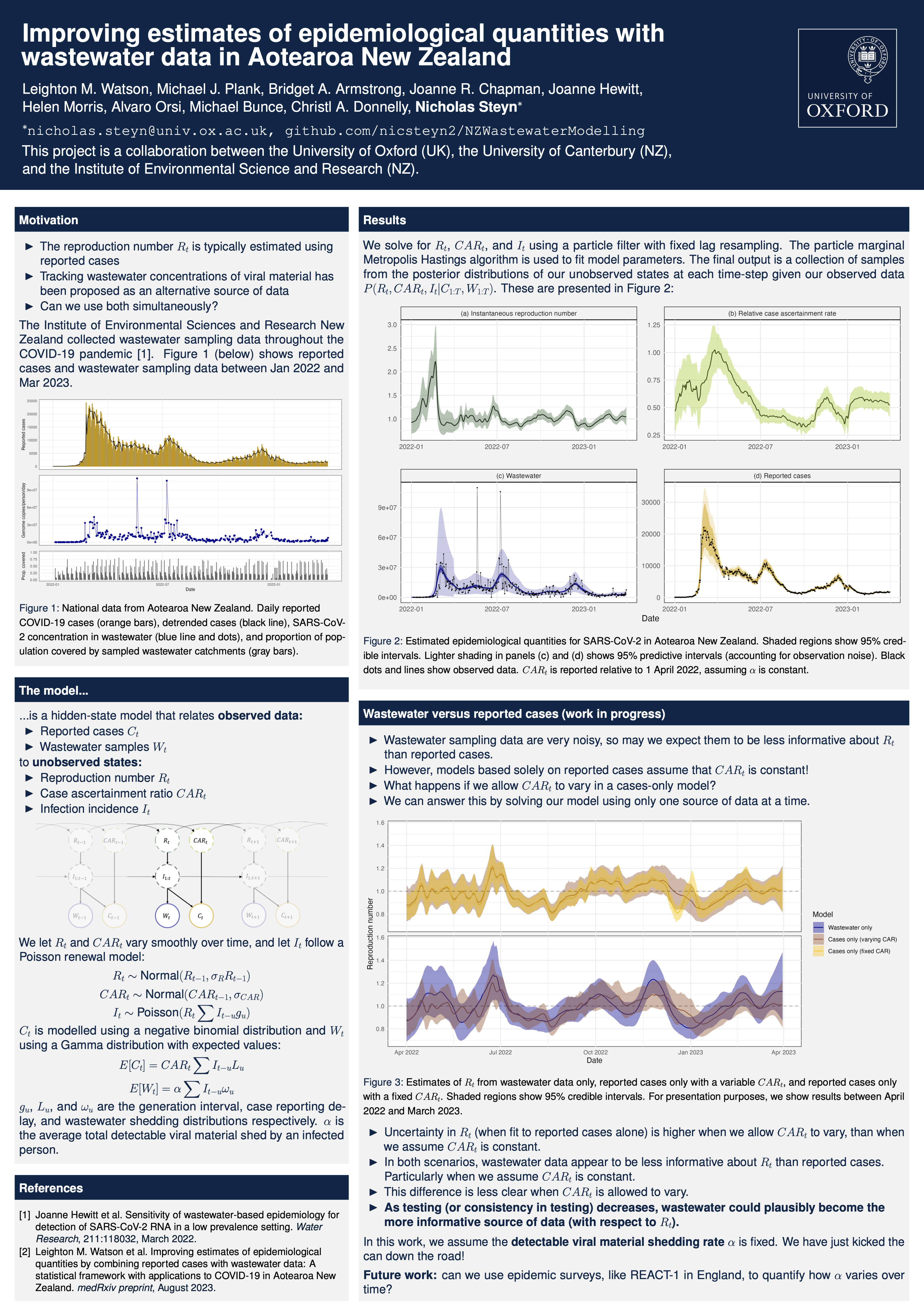Recent publications
Steyn, N., & Parag, K. V. (2025). Robust uncertainty quantification in popular estimators of the instantaneous reproduction number. American Journal of Epidemiology. https://doi.org/10.1093/aje/kwaf165
Steyn, N., Parag, K. V., Thompson, R. N., & Donnelly, C. A. (2025). A primer on inference and prediction with epidemic renewal models and sequential Monte Carlo. Statistics in Medicine. https://doi.org/10.1002/sim.70204
Steyn, N., Chadeau-Hyam, M., Elliott, P., & Donnelly, C. A. (2025). Bayesian modelling of repeated cross-sectional epidemic prevalence survey data. Accepted in PLOS Computational Biology. Preprint available here: https://doi.org/10.1101/2025.04.16.25325936
Steyn, N., Unwin, H. J. T., Ponmattam, J., et al. (2025). Regional and national estimates of children affected by all-cause and COVID-19-associated orphanhood and caregiver death in Brazil, by age and family circumstance. Accepted in The Lancet Regional Health Americas. Preprint available here: https://doi.org/10.1101/2025.01.31.25321479
A complete list of publications can be found lower on this page.
Preprints
Steyn, N., Bickford Smith, F., Mills, C., et al. (2025). A decision-theoretic framework for uncertainty quantification in epidemiological modelling. arXiv preprint. https://doi.org/10.48550/arXiv.2509.20013
Steyn, N., Chadeau-Hyam, M., Whitaker, M., et al. (2025). Pandemic-risk-related behaviour change in England from June 2020 to March 2022: REACT-1 study among over 2 million people. medRxiv preprint. https://doi.org/10.1101/2025.03.03.25323250
Online resources
SMC and epidemic renewal models: an online “book” demonstrating sequential Monte Carlo methods for fitting epidemic renewal models. Accompanies A primer on inference and prediction with epidemic renewal models using sequential Monte Carlo methods.
Rt estimators in Julia: short vignettes accompanying the code provided in the GitHub repository for Robust uncertainty quantification in popular estimators of the instantaneous reproduction number. Provides Julia implementation of EpiEstim and EpiFilter, as well as the corresponding parameter fitting methodology developed in the paper.
Pandemic-risk-related behavioural data portal: an R shiny server hosting a large quantity of aggregated data on pandemic-risk-related behaviours in England, collected as part of the REACT-1 study. By making these data publicly available, we hope to enable further research. Methodology can be found in our preprint.
Talks and posters
Publications
2025
Steyn, N., & Parag, K. V. (2025). Robust uncertainty quantification in popular estimators of the instantaneous reproduction number. American Journal of Epidemiology. https://doi.org/10.1093/aje/kwaf165
Ogi-Gittins, I., Steyn, N., Polonsky, J., Hart, W. S., Keita, M., Ahuka-Mundeke, S., Hill, E. M., & Thompson, R. N. (2025). Simulation-based inference of the time-dependent reproduction number from temporally aggregated and under-reported disease incidence time series data. Philosophical Transactions of the Royal Society A. http://doi.org/10.1098/rsta.2024.0412
2024
Watson, L. M., Plank, M. J., Armstrong, B. A., Chapman, J. R., Hewitt, J., Morris, H., Orsi, A., Bunce, M., Donnelly, C. A., & Steyn, N. (2024). Jointly estimating epidemiological dynamics of Covid-19 from case and wastewater data in Aotearoa New Zealand. Communications Medicine. https://doi.org/10.1038/s43856-024-00570-3
2023
Binny, R. N., Priest, P., French, N. P., Parry, M., Lustig, A., Hendy, S. C., Maclaren, O. J., Ridings, K. M., Steyn, N., Vattiato, G., & Plank, M. J. (2023). Sensitivity of Reverse Transcription Polymerase Chain Reaction Tests for Severe Acute Respiratory Syndrome Coronavirus 2 Through Time. The Journal of Infectious Diseases. https://doi.org/10.1093/infdis/jiac317
Elliott, P., Whitaker, M., Tang, D., Eales, O., Steyn, N., Bodinier, B., Wang, H., Elliott, J., Atchison, C., Ashby, D., Barclay, W., Taylor, G., Darzi, A., Cooke, G. S., Ward, H., Donnelly, C. A., Riley, S., & Chadeau-Hyam, M. (2023). Design and Implementation of a National SARS-CoV-2 Monitoring Program in England: REACT-1 Study. American Journal of Public Health. https://doi.org/10.2105/AJPH.2023.307230
2022
Elliott, P., Eales, O., Steyn, N., Tang, D., Bodinier, B., Wang, H., Elliott, J., Whitaker, M., Atchison, C., Diggle, P. J., Page, A. J., Trotter, A. J., Ashby, D., Barclay, W., Taylor, G., Ward, H., Darzi, A., Cooke, G. S., Donnelly, C. A., & Chadeau-Hyam, M. (2022). Twin peaks: the Omicron SARS-CoV-2 BA. 1 and BA. 2 epidemics in England. Science. https://doi.org/10.1126/science.abq4411
Plank, M. J., James, A., Lustig, A., Steyn, N., Binny, R. N., & Hendy, S. C. (2022). Potential reduction in transmission of COVID-19 by digital contact tracing systems: a modelling study. Mathematical Medicine and Biology. https://doi.org/10.1093/imammb/dqac002
Steyn, N., Lustig, A., Hendy, S. C., Binny, R. N., & Plank, M. J. (2022). Effect of vaccination, border testing, and quarantine requirements on the risk of COVID-19 in New Zealand: A modelling study. Infectious Disease Modelling. https://doi.org/10.1016/j.idm.2021.12.006
Steyn, N., Plank, M. J., Binny, R. N., Hendy, S. C., Lustig, A., & Ridings, K. (2022). A COVID-19 vaccination model for Aotearoa New Zealand. Scientific Reports https://doi.org/10.1038/s41598-022-06707-5
2021
Hendy, S., Steyn, N., James, A., Plank, M. J., Hannah, K., Binny, R. N., & Lustig, A. (2021). Mathematical modelling to inform New Zealand’s COVID-19 response. Journal of the Royal Society of New Zealand. https://doi.org/10.1080/03036758.2021.1876111
James, A., Plank, M. J., Hendy, S., Binny, R., Lustig, A., Steyn, N., Nesdale, A., & Verrall, A. (2021). Successful contact tracing systems for COVID-19 rely on effective quarantine and isolation. PLoS One. https://doi.org/10.1371/journal.pone.0252499
Steyn, N., Binny, R. N., Hannah, K., Hendy, S., James, A., Lustig, A., Ridings, K., Plank, M. J., & Sporle, A. (2021). Māori and Pacific People in New Zealand have higher risk of hospitalisation for COVID-19. New Zealand Medical Journal. Link to PDF
James, A., Plank, M. J., Binny, R. N., Lustig, A., Hannah, K., Hendy, S. C., & Steyn, N. (2021). A structured model for COVID-19 spread: modelling age and healthcare inequities. Mathematical Medicine and Biology. https://doi.org/10.1093/imammb/dqab006
Binny, R. N., Baker, M. G., Hendy, S. C., James, A., Lustig, A., Plank, M. J., Ridings, K. M., & Steyn, N. (2021). Early intervention is the key to success in COVID-19 control. Royal Society Open Science. https://doi.org/10.1098/rsos.210488
Steyn, N., Plank, M. J., James, A., Binny, R. N., Hendy, S. C., & Lustig, A. (2021). Managing the risk of a COVID-19 outbreak from border arrivals. Journal of the Royal Society Interface. https://doi.org/10.1098/rsif.2021.0063
Plank, M., James, A., & Steyn, N. (2021). Comment: weekly COVID-19 testing with household quarantine and contact tracing is feasible and would probably end the epidemic1. Royal Society Open Science. https://doi.org/10.1098/rsos.201546
James, A., Plank, M. J., Hendy, S., Binny, R. N., Lustig, A., & Steyn, N. (2021). Model-free estimation of COVID-19 transmission dynamics from a complete outbreak. PLOS ONE. https://doi.org/10.1371/journal.pone.0238800
2020
Steyn, N., Binny, R. N., Hannah, K., Hendy, S., James, A., Kukutai, T., Lustig, A., McLeod, M., Plank, M. J., Ridings, K., & Sporle, A. (2020). Estimated inequities in COVID-19 infection fatality rates by ethnicity for Aotearoa New Zealand. New Zealand Medical Journal. Link to PDF
Technical reports
Steyn, N., Plank, M. J., & Hendy, S. C. (2021). Modelling to support a future COVID-19 strategy for Aotearoa New Zealand. Link to PDF
Steyn, N., Hendy, S., Plank, M., & Binny, R. (2021). Technical report: modelling the potential spread of COVID-19 during the August 2021 outbreak. Link to PDF
James, A., Binny, R. N., Hendy, S. C., Lustig, A., Steyn, N., & Plank, M. J. (2020). Economic comparison of the use of Alert Levels 3 and 4 in eliminating the Auckland August outbreak: a cost-effectiveness analysis 21 October 2020. Link to PDF
Binny, R. N., Hendy, S. C., James, A., Lustig, A., Plank, M. J., & Steyn, N. (2020). Probability of elimination for COVID-19 in Aotearoa New Zealand. https://doi.org/10.1101/2020.08.10.20172361
Binny, R. N., Lustig, A., Brower, A., Hendy, S. C., James, A., Parry, M., Plank, M. J., & Steyn, N. (2020). Effective reproduction number for COVID-19 in Aotearoa New Zealand. https://doi.org/10.1101/2020.08.10.20172320
Binny, R. N., Hendy, S. C., James, A., Lustig, A., Plank, M. J., & Steyn, N. (2020). Effect of Alert Level 4 on Reff: review of international COVID-19 cases. https://doi.org/10.1101/2020.04.30.20086934
Plank, M. J., Binny, R. N., Hendy, S. C., Lustig, A., James, A., & Steyn, N. (2020). A stochastic model for COVID-19 spread and the effects of Alert Level 4 in Aotearoa New Zealand. https://doi.org/10.1101/2020.04.08.20058743
James, A., Hendy, S. C., Plank, M. J., & Steyn, N. (2020). Suppression and mitigation strategies for control of COVID-19 in New Zealand. https://doi.org/10.1101/2020.03.26.20044677
Media
Steyn, N., & Plank, M. J. Why strict border control remains crucial if we want to keep the travel bubble safe. The Conversation. 21 April 2021. Link
Plank, M. J., James, A., Steyn, N., & Hendy, S. C. Auckland’s rapid lockdown has given New Zealand a better chance of eliminating coronavirus – again. The Conversation. 28 August 2020. Link
Steyn, N., Plank, M. J., James, A., Binny, R. N., Lustig, A., & Hendy, S. C. A critical error in a report on lockdown timing risks undermining future decisions. The Spinoff. 10 August 2020. Link
Plank, M. J., James, A., Lustig, A., Steyn, N., Binny, R. N., & Hendy, S. C. A new community case of COVID-19 in New Zealand is a matter of when, not if. Is the country prepared for it? The Conversation. 10 August 2020. Link
Plank, M. J., James, A., Lustig, A., Steyn, N., Binny, R. N., & Hendy, S. C. How New Zealand could keep eliminating coronavirus at its border for months to come, even as the global pandemic worsens. The Conversation. 16 July 2020. Link
Plank, M. J., James, A., Lustig, A., Steyn, N., Binny, R. N., & Hendy, S. C. 2 new COVID-19 cases in New Zealand, but elimination of community transmission still stands. The Conversation. 16 June 2020. Link
Plank, M. J., James, A., Lustig, A., Steyn, N., Binny, R. N., & Hendy, S. C. New Zealand hits a 95% chance of eliminating coronavirus – but we predict new cases will emerge. The Conversation. 4 June 2020. Link
Awards
Prime Minister’s Science Prize. 2020. Awarded for a “transformative scientific discovery or achievement” with a significant impact on New Zealand. This was awarded for our work on modelling during the COVID-19 pandemic in New Zealand.
Footnotes
This is a published comment piece on a paper arguing that household quarantine and contact tracing would have been sufficient to end the pandemic. We were arguing that it would not have been sufficient.↩︎


